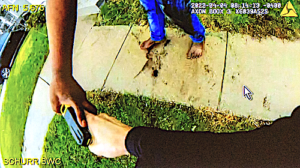Body camera footage from the Grand Rapids Police Department captures the sequence of events that led to the fatal shooting involving former Officer Christopher Schurr. The incident began when Schurr reportedly initiated a traffic stop after noticing that the license plate on the suspect’s vehicle did not match the vehicle’s registration.

According to the footage and police reports, the suspect refused multiple requests to provide a driver’s license or cooperate with the stop. Moments later, he fled on foot, prompting Officer Schurr to give chase.
As the pursuit continued, a physical struggle broke out between the two. The suspect reportedly attempted to take control of the officer’s taser during the altercation. Bodycam video shows Officer Schurr repeatedly ordering the suspect to release the weapon, but the commands were ignored. The struggle intensified as the two wrestled on the ground.
At one point, Officer Schurr, visibly fatigued and still engaged in a violent struggle, drew his service weapon. He then fired a single shot that struck and killed the suspect.
The incident has drawn widespread attention, both for its tragic outcome and for its implications regarding use-of-force policies in law enforcement. During the subsequent investigation and legal proceedings, expert witnesses were called to testify on the appropriateness of Officer Schurr’s actions. Multiple experts concluded that the use of deadly force in this case was justified under the circumstances, citing the immediate threat posed by the attempted disarming of the officer and the suspect’s continued resistance.
The case remains a point of public debate, but the official findings underscore the complex and often split-second decisions officers must make during high-stress encounters.
